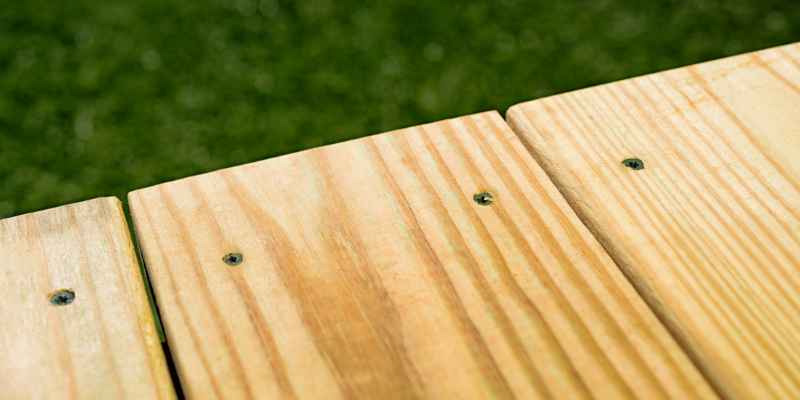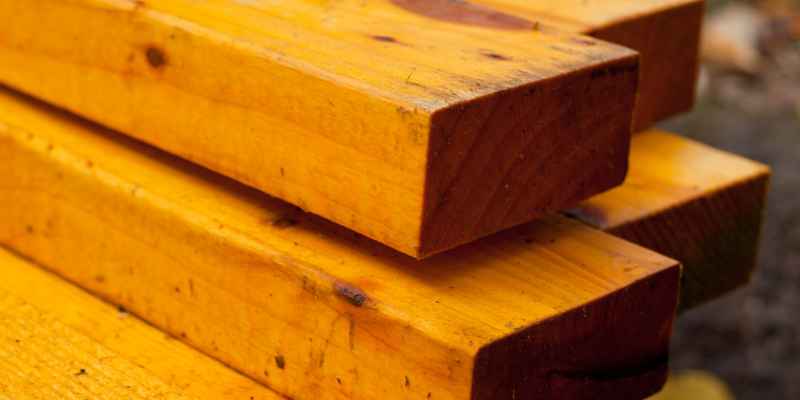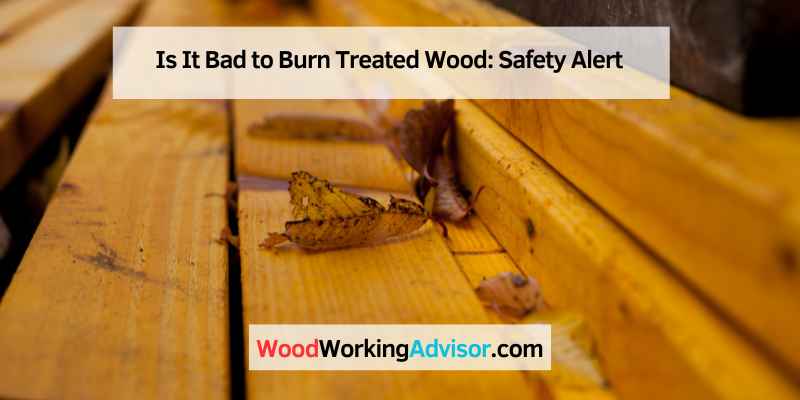Burning treated wood, such as pressure-treated or chemically preserved wood, can release harmful chemicals and pollutants into the air, posing a risk to both human health and the environment. These chemicals can create toxic fumes and a dangerous atmosphere, particularly for children, older individuals, and those with respiratory conditions.
It is important to avoid burning treated wood to prevent the release of these harmful substances.
The Dangers Of Burning Treated Wood
Burning treated wood can pose significant health risks and environmental dangers. When treated wood is burned, it releases toxic chemicals into the air, which can be harmful to human health, particularly for children, older individuals, and those with respiratory conditions. This section will explore the chemicals found in treated wood and the health risks associated with burning it.
Chemicals In Treated Wood
Treated wood is often laden with chemicals that can be harmful when burned. These chemicals are used to protect the wood from rotting or decaying in wet conditions. Some common chemicals found in treated wood include:
- Arsenic
- Chrome
- Copper
- Cadmium
- Lead
- Zinc
When these chemicals are released into the air during combustion, they can cause serious health issues.
Health Risks Of Burning Treated Wood
Burning treated wood releases toxic fumes and creates a dangerous atmosphere in your home or environment. The health risks associated with burning treated wood include:
- Respiratory problems
- Irritation of the eyes, nose, and throat
- Headaches and dizziness
- Nausea and vomiting
- Long-term exposure can lead to more severe health issues, such as cancer
It’s crucial to avoid exposure to the smoke or ash produced by burning treated wood to protect your health and the environment.
Even burning pressure-treated lumber, which is commonly used for outdoor construction, can release harmful chemicals into the air. Older lumber may even contain arsenic, further increasing the health risks.
Additionally, burning treated wood not only poses risks to human health but also to the environment. The chemicals released can contaminate the soil, water, and air, leading to negative effects on plants, animals, and ecosystems.
Therefore, it is essential to find safer alternatives for disposing of treated wood rather than burning it.
Impact On Health And Environment
Burning treated wood can have severe consequences on both health and the environment. It is crucial to understand the toxic fumes and air pollution that can result from burning treated wood, as well as the environmental hazard and legal ramifications associated with this practice.
Toxic Fumes And Air Pollution
When treated or painted wood is burned, it releases toxic fumes that can pose serious health risks. These fumes can create a dangerous atmosphere in your home, particularly harmful to vulnerable individuals like children, the elderly, or those with respiratory conditions.
Environmental Hazard And Legal Ramifications
Chemicals released from burning treated wood contribute to environmental hazards. It is important to note that burning treated wood, which contains preservatives such as arsenic, can lead to legal ramifications. Disposing of treated wood improperly can result in negative impacts on both human health and the surrounding ecosystem.
Regulations And Safe Disposal
Burning treated wood can pose serious risks to your health and the environment.
Proper Disposal Methods
When it comes to disposing of treated wood, it is important to follow safe methods:
- Take treated wood to a designated disposal facility
- Avoid burning treated wood in fire pits or open fires
- Recycle or repurpose the wood if possible
Legal Restrictions On Burning Treated Wood
There are stringent legal restrictions on burning treated wood due to the release of harmful chemicals:
- Chemicals in treated wood can create toxic fumes
- Burning treated wood can harm vulnerable individuals
- Avoid exposure to smoke or ash from burning treated wood
Remember, it is illegal to burn treated wood for a reason – the toxic fumes can be harmful to your health and the environment.
Alternative Options For Treated Wood
Burning treated wood, particularly pressure-treated or chemically preserved wood, can release harmful chemicals and toxic fumes that can be dangerous to your health and the environment. It is best to avoid burning treated wood and opt for alternative options to ensure safety.
Recycling And Reuse
Instead of burning treated wood, consider recycling or reusing it. Many recycling centers accept treated wood and have specific processes for handling it. By recycling treated wood, you can prevent the release of harmful chemicals into the environment and reduce the demand for new wood.
Safer Alternatives For Wood Burning
If you’re looking to create a cozy atmosphere without burning treated wood, there are safer alternatives available. Consider using alternative materials such as untreated wood, natural gas, electric heaters, or propane fire pits. These options provide warmth and ambiance without the associated health risks.
Recycling And Reuse Benefits
| Benefits | Explanation |
|---|---|
| Prevent chemical release | Recycling treated wood prevents the release of harmful chemicals into the environment. |
| Reduce demand for new wood | By reusing treated wood, you can help conserve natural resources and reduce deforestation. |
| Contribute to a circular economy | By recycling treated wood, you support the concept of recycling and contribute to a sustainable future. |
Instead of burning treated wood, consider these alternative options for recycling, reusing, or using safer alternatives for wood burning. By making informed choices, you can protect your health and help preserve the environment.
Community Education And Awareness

Community education and awareness play a crucial role in addressing the issue surrounding burning treated wood. It is essential to educate the public about the potential dangers of burning treated wood, while also promoting alternative, safe disposal methods and materials. By increasing awareness and knowledge within the community, individuals can make informed decisions to protect their health and the environment.
Educational Campaigns And Outreach
Educational campaigns are instrumental in disseminating information about the risks associated with burning treated wood. These initiatives involve the creation of engaging and informative content, such as brochures, posters, and online resources, to reach a wider audience. Outreach efforts may include organizing seminars, workshops, and community events to educate residents about the hazardous effects of burning treated wood and provide them with eco-friendly alternatives.
Community Advocacy And Engagement
Community advocacy and engagement are vital aspects of raising awareness about the dangers of burning treated wood. This involves partnering with local organizations, environmental groups, and government agencies to advocate for safer disposal practices. Engaging with the community through social media platforms, neighborhood forums, and interactive discussions can foster a sense of collective responsibility and encourage individuals to adopt more sustainable methods.
Testimonials And Expert Opinions
When considering the question, “Is it bad to burn treated wood?” it is crucial to seek insights from environmental experts and consider the experiences of individuals and communities. Testimonials and expert opinions provide valuable perspectives on the potential dangers of burning treated wood and the impact it can have on human health and the environment.
Insights From Environmental Experts
Environmental experts emphasize the detrimental effects of burning treated wood. The chemicals present in treated wood, such as arsenic, can release toxic fumes when burned, posing significant health risks to individuals, especially children, older people, and those with existing respiratory conditions. Additionally, the hazardous substances released during the burning process can create a dangerous atmosphere in homes.
Experiences Of Individuals And Communities
The experiences of individuals and communities further highlight the risks associated with burning treated wood. Testimonials demonstrate the potential harm caused by the release of toxic chemicals into the environment, affecting not only human health but also posing hazards to fish and wildlife. Communities have also raised concerns about the illegal burning of treated lumber and its impact on coastal environments. These real-life experiences underscore the importance of avoiding the burning of treated wood to safeguard public health and environmental well-being.
Best Practices For Safety
Burning treated wood can be harmful as it releases toxic chemicals. It is best to avoid burning pressure-treated wood, as it can produce harmful fumes that may pose health risks, especially for children, older individuals, and those with respiratory conditions.
Protect your health and the environment by refraining from burning treated wood.
Safe Handling And Storage Of Treated Wood
Ensure proper ventilation when handling treated wood to minimize chemical exposure.
Wear protective gloves and a mask to avoid direct contact and inhalation of harmful substances.
Store treated wood in a covered area away from living spaces to prevent air contamination.
Educating Others About The Dangers
- Inform others about the risks of burning treated wood for health safety.
- Explain the importance of using alternative disposal methods to reduce environmental harm.
- Encourage compliance with regulations that prohibit burning treated wood to protect ecosystems.

Frequently Asked Questions On Is It Bad To Burn Treated Wood
Is It Safe To Burn 20 Year Old Pressure Treated Wood?
Burning 20-year-old pressure treated wood is not safe due to the harmful chemicals it releases when burned.
Can You Burn Wood That Has Been Treated?
Burning treated wood, including pressure-treated or painted wood, is not recommended. It contains chemicals that can be harmful when burned, releasing toxic fumes into the air. This can create a dangerous environment for people, especially those with respiratory conditions. Avoid burning treated wood for the safety of your health and the environment.
Is Pressure Treated Wood Toxic To Humans?
Burning pressure treated wood releases harmful chemicals that can be toxic to humans when inhaled.
Can You Burn Treated Timber In A Fire Pit?
Burning treated timber in a fire pit releases harmful chemicals that can harm health and the environment, including toxic fumes.
Conclusion
Burning treated wood can have harmful effects on both our health and the environment. The chemicals present in treated wood can release toxic fumes when burned, creating a dangerous atmosphere in our homes. It is crucial to avoid burning pressure-treated or chemically preserved wood, as this can release harmful chemicals into the air.
This is especially important for the safety of children, older individuals, and those with respiratory conditions. Instead, it is recommended to burn hot fires and avoid burning garbage or plastic. Prioritizing our health and the well-being of our environment, it is best to refrain from burning treated wood.


